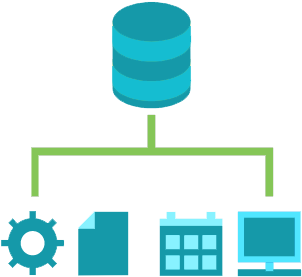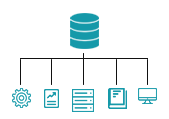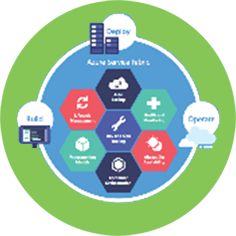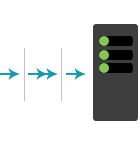April 27, 2021

Having a mobile phone or two is pretty much the norm now for practically anyone. Most people however underestimate just how much our everyday lives are intertwined with our phones and the value of the information it truly holds. The reality is that your phone practically has your entire life on it or at the very least has direct access to every important aspect of your lives.
Your phone is effectively a portable storage device that holds whatever data you decide to store on it, together with information on your contacts. It is sometimes used as a mobile bank, a social networking hub, a hotspot hub, to browse the internet on the go, and even as authenticators for some of your most valuable accounts.
On the business side of things, mobile devices and related apps can bring with them countless opportunities to grow a business be it through internal apps to boost efficiency and productivity, partner-facing apps to foster closer business relationships, or customer-facing apps to act as a touchpoint for your customers. Unfortunately for us, the popularity of apps coupled with the value of the information they carry, also makes them a prime target for people of the unscrupulous kind. People who seek to violate your privacy and steal any information stored on your phone.

By some estimates, up to 76% of Mobile Apps Could Contain Security Flaws and one out of every 36 mobile devices have high-risk apps installed. Worse still it has been found that 71% of fraud transactions came from mobile apps and mobile browsers in the second quarter of 2018 compared to 29% on the web, up 16% year over year. Worse still, the very same advances in technology that facilitate our everyday lives also help hackers launch increasingly more complex attacks. They should never be underestimated in their ingenuity. They can easily manipulate or steal the information on your phone. Hacking may not always mean simply stealing usernames and passwords or sending phishing emails. They could even be listening in on conversations or hacking into any data piled on your phone.
However, the threat to mobile phones is not restricted to individuals alone; it can drastically affect the productivity, and success of a business; especially so if said business’ app was the reason for the breach. In fact, it is well known that data breaches could cost enterprises millions, and public reporting of a breach can severely impact a brand’s reputation.

To further put such security compromises into perspective, take into consideration that there have already been major breaches in 2020 already. Photo Squared’s app was compromised and 100,000 individual details were exposed. Peekaboo Moments, an app for parents to post pics of their kids, was compromised through an unsecured server. This is unfortunate by any perspective but gets worse when you realize that Peekaboo has been downloaded more than 1 million times. And then we have Key Ring, a digital wallet app that left stored data, including full payment details, for 14 million customers exposed.
Since smartphone and mobile app users will only increase in the future, reliable mobile security is an absolute must today if you wish to not have your business’ name accompany those mentioned above. The best way to keep this in check and protect your business is to always stay one step ahead of hackers and ensure the apps you produce are free of vulnerabilities and utilize the proper app security best practices. This is where mobile app security assessments come in.
They are an essential cybersecurity measure for any enterprise with publicly available apps. Professional cybersecurity experts can assess the strength of an application against known and potential threats to protect not only your users but also the enterprise from potential disasters. Proper assessments can give you confidence in the security of your mobile apps and APIs. They reduce risks, save time, and implement actionable security measures to not only improve safety but meet mandatory compliance. A professional security assessment covering this testing is the best practice to assess the security controls of your application.
What are the real risks and vulnerabilities to corporates?
Mobile applications are fast becoming the primary source of fraud and breaches for organizations. Security and risk management leaders must follow mobile best practices to avoid data leakage from mobile devices and attacks on infrastructure.

Furthermore, when a user agrees to the terms and conditions of your app, your organization now becomes responsible for the personal data of the user. Unfortunately, business apps are three times more likely to leak login credentials than the average app. If an app does not have adequate mobile security to protect against data leaks and vulnerabilities, your enterprise could be in big trouble.
Without thorough security testing, threat actors could infect your app with malware or spyware, and it could leave your users’ financial account information and personal credentials exposed. The official Apple and Google app stores do not strictly monitor apps — and without investing in your own thorough mobile app security, threat actors could leverage your app to steal data and money, and severely hurt your enterprise’s reputation.
As a result, mobile application security has become a tangible problem for enterprises. While mobile device security itself has not been a major source of preoccupation and breaches, mobile application security failures are increasingly responsible for fraud and enterprise breaches. Often, these are public facing apps that may be the primary or only way an organization is able to interact with its customers or partners. Because they can run on any mobile device, these apps are run in a hostile environment. As such, they must be effectively protected to enable the organization to advance toward its digital transformation goals.
Unfortunately, app developers are not necessarily security experts. Their skills are in developing and coding apps and working with user interfaces. As such, most companies are not aware of the specific risks involved. They are more concerned with not ending up in the news for the wrong reasons.
So in order to effectively address these concerns, it is vital to identify the specific risks that come with mobile applications. And the best way to do so is to conduct a threat modeling exercise, looking at the function of the mobile application and the threats applicable during its operation. Broadly speaking, the main risks for enterprises that use enterprise data with mobile applications are:
- Sensitive data loss — Applications that lack adequate protection can allow attackers to obtain sensitive data that may reside in these applications, such as payment credentials and intellectual property. Some threat vectors can be device theft or loss, malware on the device, and man in the middle (MitM) over unsecured networks.
- Exposure of infrastructure — Mobile applications need to communicate with enterprise back end services. This requires the enterprise to expose internal resources, such as an API or enterprise databases. If uncontrolled, this exposure can lead to a number of attacks, such as API scraping and denial of service.
- Fraud — This risk is particularly accentuated in financial services and retail applications, and wherever a mobile application includes financial transaction functionality where payment credentials are expected to be exchanged. The techniques attackers use includes repackaging, SMS grabbing through malware, script injection, and overlay attacks.
- Compliance — Certain apps, especially those with access to financial transactions and a customer’s personal information, are subject to specific compliance regulations. Noncompliance with these regulations may lead to fines.
Further still, the type and level of security required to keep an app secure are heavily dependent on several factors such as whether the app is published onto a commercial app store or distributed through enterprise distribution. For consumer-facing apps, the requirements will be relatively obvious; less so for workforce and partner-facing applications. Privately distributed apps will be less subject to attacks such as reverse engineering, and they will allow somewhat more visibility over the device.
So, What Exactly Is Mobile App Security Testing?
Broadly speaking, Application Security Testing (AST) is the process of testing and examining an application to ensure that mobile apps, web applications, or APIs are secure from potential attacks.

Often, organizations often lack the expertise and bandwidth to monitor their applications adequately and adapt their security protocol to mitigate emerging threats. Furthermore, ever-evolving compliance laws require enterprises to follow strict mandates to protect people from attacks and data loss. Further adding to its complexity, each enterprise is unique and requires expert guidance to develop a security strategy equipped to meet its specific standards and requirements.
As a result, application security is a critical practice within the software development life cycle (SDLC) of any app and covers multiple techniques, from early development stages through to, and including, production. Efficient, successful AST relies on knowing when and how frequently to test during the SDLC, as well as which technology is the best fit for a given stage. This is also critical as an organization embraces agile development methodologies and DevOps practices, where security testing needs to be integrated and automated as much as possible.
The effective implementation of AST practices will ensure an enterprise can focus more on developing and improving business with the assurance that applications are secure from potential danger. In doing so, it helps increase operational efficiency, addresses compliance requirements, reduces risk, and improves trust between a business and users.
How Does It Work?
Broadly speaking mobile app security assessment will be focused on achieving four primary goals:
- Using simulated attacks to assess the security strengths and weaknesses of your app.
- Examine the code to identify any potential malware and danger as well as analyzing internal controls.
- Monitoring the application interface and infrastructure to locate any security flaws.
- Improving security posture and crafting an actionable security plan with expert guidance.

To effectively achieve these goals, an application needs to undergo AST as early in its development as possible. This is primarily because public data on application security vulnerabilities shows that well-known types of vulnerabilities, many of which AST can readily detect, are still commonly found in modern application design and code. As such, the question isn’t whether to integrate AST into your SDLC, but rather where and how to do it.
A traditional software build-and-release pipeline contains three broad phases – Development, prerelease, and Production. Effective AST should generally be structured in such a way as to perfectly integrate and automate itself to run seamlessly within each of these phases, irrespective of the overall development methodology. When an application goes through the complete build pipeline, the type, depth, and frequency of testing vary in each of these phases as follows:
- Development: Entails extensive security testing at several stages of the build pipeline to support early identification and remediation of vulnerabilities; the bulk of vulnerability identification and remediation should happen in this phase.
- Prerelease: Testing to validate the outcomes of earlier testing and to provide an opportunity to use a more diversified set of tools and practices so that additional vulnerabilities may be caught.
- Production: Ensures that emerging vulnerabilities, as well as those that may arise from accidental or malicious changes to these environments, are caught using continuous and production-safe scanning.
Furthermore, AST is a necessary practice as part of an overall application security program and should not exist as a stand-alone activity. Otherwise, an organization runs the risk of being stuck in a cycle of creating, detecting, and fixing vulnerabilities in software with no strategy to improve application security over the long term.
In addition, the level and type of testing are heavily dependent on several factors such as economic sector, industry vertical, geographic region, application functionality, and types of data transmitted/stored, you may be impacted by regulations that also require some level of AST. Common examples of regulations that impact organizations include:
- Payment Card Industry Data Security Standard (PCI DSS), for applications that process credit card payments or store cardholder data.
- Health Insurance Portability and Accountability Act (HIPAA), for applications that handle or store health information.
- General Data Protection Regulation (GDPR), which impacts all organizations globally if they process or store data about European Union citizens.
Some regulations overlap in what is mandated or prescribed, and in some cases (like HIPAA) technical specifics can be lacking. However, for those impacted applications or data, adopting AST as a regular process is almost universally accepted and recommended. Furthermore, implementing AST throughout the development, prerelease, and production phases will always be far more effective and efficient. The early identification of vulnerabilities means developers can often address and resolve them more easily, and more quickly, thereby avoiding surprises late in the SDLC. Finding vulnerabilities late in development or after production release can result in significant delays and added expense for fixes. This is especially true in cases where development is outsourced, makes use of third-party integrations, or is spread across multiple internal teams. In agile development methodologies and DevOps practices, the speed of security testing also becomes a potential roadblock.
In theory, a security team could extensively test an application in its staging environment and find the same number of vulnerabilities as the team would have found with multiphase testing. However, the significant time and cost savings that result from utilizing the services of an AST service provider offering the complete three-phased testing system will ensure your project deadlines are always met.
Ultimately, the goal of implementing AST practices is to provide comprehensive and effective security testing. Organizations should test as many applications in their portfolio as possible, and as often as necessary, to maintain the proper level of assurance. However, this may not always be the case and your application may already be in production by now. If this is the case, you need not worry, as it is never too late. You can always perform security testing; even at later stages of the SDLC. Be it in preproduction or postproduction conducting AST on a regular basis is an industry best practice that ensures an application is always sufficiently tested while in use.
What does ODP Offer?
At ODP we view mobile app security and secure coding as a continuous, iterative process and want to become part of your development and testing process. As such, not only do we offer the complete gamut of three-phase testing, but also so much more.

First and foremost, we bring our top security experts onto your team where they begin by mapping your application for each type of operating system. As a detailed understanding of the application’s data flow is produced, they can assess any vulnerabilities that may exist. Moreover, our mobile app security team supports app development in both iOS and Android. Swift and Xamarin are included. Our expertise together with those of our partners also ensures your coverage against your biggest external threats.
We also offer secured backup in a world-class TIA 942 Rating 3 certified Data Center with a dedicated Security Operations Center. Such secure off-Site storage improves your data security and helps you meet the required data protection standards. It also assists in the fast recovery of all your data inputs using real-time applications to avoid data loss, which is perfect for applications that carry critical transactions. But best of all, our services are completely scalable, making them perfect for businesses or individuals with differing app development needs and schedules
So, as we work together to build the security of your app, you can be confident that the product you release to the marketplace will keep both your customers’ data and your own reputation protected.
So, what are you waiting for? Get your applications checked and implement our class-leading AST practices as soon as possible to guarantee success. For more information on the AST services we offer, please visit https://www.omandatapark.com/mobile-app-security-assessment/ or call +968 2417 1111.









































